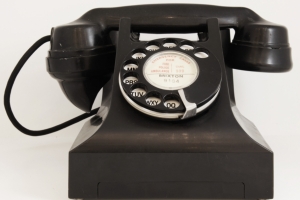
Bakelite is the earliest commercial synthetic polymer resin, and has become something of a cult material. Objects made from it have a nice heavy, clunky feel - a bit like ivory. Bakelite jewellery is now highly prized and very collectible.
It was developed by Belgian chemist Dr. Baekeland and patented in 1909. He was looking for a economical, synthetic alternative to shellac, a natural polymer with great insulating and waterproofing qualities, used increasingly in the burgeoning electrical industries, but very expensive to produce with a tendency to degrade over time. Baekeland developed a material from phenol resin and wood dust as filler, which was mouldable, and would heat-cure to become robust and stable.
Non conductive and resistant to heat and chemical damage, Bakelite was widely used for things like pipe stems, electrical insulators and appliances: radios and telephones like this one. There were also many military uses for the material, a fact which weighed heavily on Baekeland’s conscience. It is still used today, where its specific properties are required: industrially, in car components and electrical wiring, and in the making of gaming dice.
Bakelite was named as a National Historic Chemical Landmark, by the American Chemical Society. It paved the way for the introduction of so many other plastics and modern materials that it was hard for the consumer to tell them apart, and people began to lump all plastics into one generic term: Bakelite. One of the ways to tell if a Bakelite object is genuine is to rub it; when warmed with friction, it should give off an unmistakable whiff of formaldehyde.
Sample ID: 474
Add materials you find interesting to your own selections.
Use the  button to select a material and get started.
button to select a material and get started.

